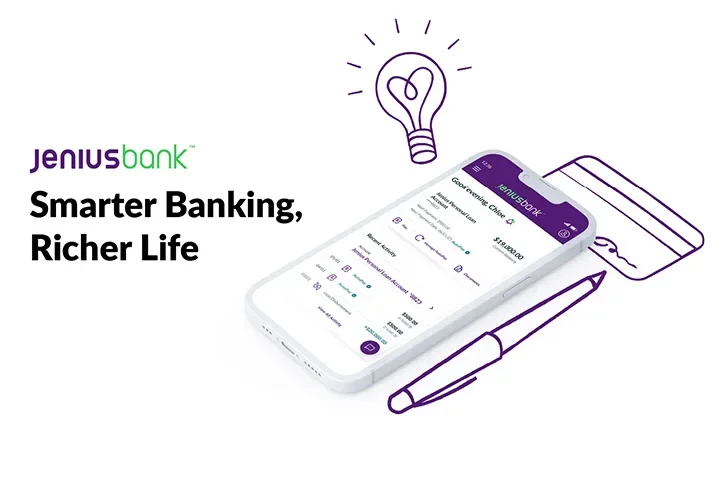Establishment of Jenius Bank : Why SMBC Group Is Tackling Digital Banking in the U.S.

Digital banks without any physical branches are spreading rapidly throughout the world. They are highly convenient, allowing customers to use their smartphones to do everything from opening an account to making deposits and transfers. In 2022, SMBC Group announced it will be opening Jenius Bank, a digital bank for retail customers living in the United States.
So why does SMBC Group, a Japanese megabank, plan to launch a digital bank in America? What services will the bank provide and what strategies will it rely on? We spoke with Daisuke Tanaka, deputy general manager of SMBC’s Strategic Planning Department, Americas Division, about the process from conception to establishment.
SERIES: Digital Banking in the U.S.
- Establishment of Jenius Bank : Why SMBC Group Is Tackling Digital Banking in the U.S.
- Creating New History of SMBC Group in America : An Inside Look at the People Taking On the Digital Banking Business
- Smarter Banking, Richer Life: The Vision of Jenius Bank
- Concept for a digital bank came from direct talks with the president
- As a digital bank, becoming a full-service financial institution in the growing American market
- A rigorous customer orientation—using data to eliminate inconvenience
- Providing various products in line with the life stages of customers
- An environment for tackling new business on the stable platform of SMBC Group
Concept for a digital bank came from direct talks with the president
SMBC announced in August 2022 that it was entering the digital banking business in the U.S. What took place up to the point that decision was made?
My expat colleagues and I would often talk about how SMBC should develop its business in America. When considering five or ten years into the future, we felt we needed to diversify operations and not just try to increase in size. One idea that came out of this was a digital bank business that would serve to diversify our U.S. dollar procurement by taking deposits from retail customers. It seemed promising enough, so I drew up a PowerPoint presentation about ten pages long. That was the start of the whole process.

Right now in America, banks are strictly regulated by the authorities and it is not possible to make major acquisitions. For this reason, banks have to launch new ventures themselves. I’d been interested in digital banking since the time I was working in Japan, so I had some knowledge of it. Based on the knowledge I had, I drew up a presentation on my idea for a new digital bank and presented it first to Yoshihiro Hyakutome, who was head of the Americas Division at the time and who also had experience managing digital banking services in Indonesia. The result was that he said, “Let’s do it,” so we then presented the idea to SMBC Group President Ohta when he was in the U.S.
President Ohta has consistently emphasized the importance of breaking the mold and has made clear that he wants to create a number of ten-billion-yen businesses. When I presented the idea to him, he immediately understood our proposal and we moved right away to discussing specifics.
So was it smooth sailing from there until the official decision was made?
In the process until the idea was realized, there were a lot of struggles as well. We interviewed people at Marcus, the digital banking business of the Goldman Sachs Group, and people at Barclays, a U.K. financial institution, and elsewhere and added to our store of knowledge. It still would have been quite difficult to develop a concrete plan on our own, so we hired a specialized consultant and conducted a feasibility study.(*1)
Even before the final approval, we hired our first employee, John Rosenfeld, who had experience leading a digital bank for a major regional bank in the U.S. Having John, someone with first-hand experience in digital banking, join our team was a big first step to realizing our vision for a digital bank. We fleshed out a business plan together and obtained official approval for the project.
*1.An assessment of whether a new product or service is actually executable or realizable.

As a digital bank, becoming a full-service financial institution in the growing American market
What is the global situation with digital banks right now?
Digital banks are all currently striving to become full-service retail financial institutions. The same is true of Jenius Bank. We plan to release not just one product but a wide range of products in stages so as to be able to support our customers at every stage of their lives. In the future, we intend to offer investment products and online securities brokerage services as well. We want to be a retail financial platform that provides full-service support for our customers.
But among the banks that have arrived at this end point, there is still no out-and-out winner. The bank that is closest to that goal is probably SoFi,(*2) but in terms of size, it is really not that big. Ally,(*3) which is famous for auto finance, is trying to transform into a full-service financial institution, but consumers still tend to equate it with auto finance.
*2.An American digital bank with strength in student loans.
*3.One of the largest digital banks in the U.S., involved in auto financing.
What advantages does SMBC Group possess in operating a digital bank in the U.S.?
The American market is huge, and it is growing significantly, even just looking at ordinary deposits. Digital deposits are also growing by up to double-digit percentages, so it is an appealing market that is growing much more than the Japanese market. It is also much more difficult in the U.S. to acquire a banking license than in Japan. In Japan, companies from e-commerce and retail have been able to enter the banking sector; Rakuten Bank and Seven Bank are some examples. But in America, there is no Amazon Bank, no Walmart Bank. It is extremely difficult for non-banking companies to enter the business. Many fintech companies are struggling because they’ve been unable to acquire a banking license. Even if start-ups succeed in entering the sector, they have to quickly establish a track record in order to get support from venture capital. They tend to have short-sighted strategies as a result, but this does not apply to us.
In terms of prospects, Jenius Bank is striving to be a business that makes a significant contribution in ten years’ time to the revenues of SMBC Group overall. However, to achieve this, we just need to acquire around a 1% share of the American retail banking market. We don’t have to compete with the likes of JPMorgan Chase and Citibank. Our sights are on a targeted, niche market.

So you’re aiming for a small, less competitive part of an enormous market.
Yes. Moreover, thanks to the progress in technology in recent years, the initial investment costs for a digital bank have come down significantly. It now costs less to set up a digital bank than to build a new physical branch—this is an advantage.
A rigorous customer orientation—using data to eliminate inconvenience
In carrying out a digital banking business, what values do you emphasize? What is your core concept?
To be a bank that retail customers use for a long, long time. Digital banks don’t have any opportunity to meet face to face with customers, so we plan to stay in contact with them through a mobile app and use data to provide a full-service customer experience. For example, we can make it possible on the Jenius Bank app to consolidate and view account information from other financial institutions.
In the U.S., with the customer’s approval, one bank can obtain that customer’s account information of another bank. This includes not only the account balance, but information like where the customer used their debit card to make payments. How we use this information to enhance the customer experience will be key.
In future, by sharing this data, we hope to eliminate inconvenience for customers. For example, when you open an account, you enter your personal information, but later if you apply for a home loan, you have to deal with the hassle of entering that same information again. There are many cases of data not being effectively shared even within the same financial group. We want to take the lead in eliminating this kind of inconvenience. By sharing the information provided when opening an account, we plan to provide financial products much faster.
Another thing we are doing is getting rid of late fees. American banks charge late fees of 20 or 30 dollars when loan payments, for example, are even a day late, but we are basically shooting for no fees. Our customer orientation will be very rigorous.
Providing various products in line with the life stages of customers
Who is your target customer?
People who use digital applications in their daily lives. We want to be a bank that people use when they need money because of a change in their stage of life, whether that be marriage, the birth of a child, a child going away to college, the purchase of a house or car, or other such events. We will enhance our product lineup because new needs, for investment products, for instance, emerge as people progress through life’s stages. We are also considering introducing robo-advisors powered by AI.
So, you will flexibly provide products based on changes in the life stages of your core target?
Yes, we want to steadily increase the financial products we provide. One of the characteristics of the American market is that the account balances of retail customers decrease when the stock market is booming. If Jenius Bank is not providing services other than deposits at such times, funds will just flow out of the bank. For this reason, we want to quickly add an investment function and create a mechanism for the circulation of funds within the Jenius Bank’s ecosystem.
What services and areas will you strengthen to satisfy the needs of digital natives?
The user experience of our mobile app. It’s not so easy to differentiate our bank through our financial products themselves, so we will focus on using data and providing an app that offers superior convenience. Jenius Bank has already created accounts on Instagram and Twitter, so we will clearly set our sights on our target and carry out efficient marketing on social media as well.
Megabanks seem to be developing products targeted at all consumers, so is a strategy like yours with a narrowed target unprecedented?
I believe so. If we tried to do the same thing in Japan, it would likely be extremely difficult. I mentioned Marcus earlier, the digital bank of the Goldman Sachs Group, and partly because America is its home market, its definition of success is likely to include attainment of an enormous scale of business. Luckily, our home market is not the U.S., so we don’t have to aim for the top. I think this starting point is what makes our strategy possible.
An environment for tackling new business on the stable platform of SMBC Group
What are the defining characteristics of startups launched by large corporations?
One reason I’m glad we’re a large company is that a large amount of investment was forthcoming right from the beginning. The $150 million we received initially is normally the amount received in series D, the fourth round of investment. Normally, to receive this much investment, you would have to build up many small successes, but we skipped this process entirely and are now able to take the shortest route possible toward targets set for five to ten years down the road—this is a major advantage.
We currently have around 250 employees and many of them joined the company because they saw the appeal of having SMBC Group in the background. For people in banking, switching over to fintech may seem a bit risky, but at Jenius Bank, we are able to engage in a progressive digital banking business with the stable capital of SMBC Group. There are a lot of people at conventional banks who want to start new ventures, so for those people as well, I think this environment that allows them to tackle a new business is extremely appealing.

What does the future hold for Jenius Bank?
We are working to open in 2023. We will then gradually expand our product lineup with a view to achieving profitability. Moreover, in ten years, we want to be a bank that is fairly well known in the digital bank arena.
SERIES: Digital Banking in the U.S.
- Establishment of Jenius Bank : Why SMBC Group Is Tackling Digital Banking in the U.S.
- Creating New History of SMBC Group in America : An Inside Look at the People Taking On the Digital Banking Business
- Smarter Banking, Richer Life: The Vision of Jenius Bank
-

Deputy General Manager, Strategic Planning Department, Americas Division, SMBC
Daisuke Tanaka
Graduated from college and joined a securities company. Obtained an MBA in the U.S. and joined SMBC in 2013. Engaged in the Group’s reorganization, projects to invest in overseas financial institutions, and other duties. Appointed to his current position in 2018. Leads the bank’s growth strategy in the Americas, including the digital bank project and other investments.
